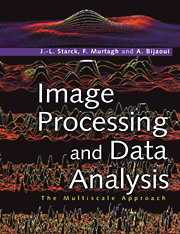Book contents
- Frontmatter
- Contents
- Preface
- 1 The wavelet transform
- 2 Multiresolution support and filtering
- 3 Deconvolution
- 4 1D signals and Euclidean data analysis
- 5 Geometric registration
- 6 Disparity analysis in remote sensing
- 7 Image compression
- 8 Object detection and point clustering
- 9 Multiscale vision models
- APPENDIX A Variance stabilization
- APPENDIX B Software information
- APPENDIX C Acronyms
- Bibliography
- Index
APPENDIX B - Software information
Published online by Cambridge University Press: 30 October 2009
- Frontmatter
- Contents
- Preface
- 1 The wavelet transform
- 2 Multiresolution support and filtering
- 3 Deconvolution
- 4 1D signals and Euclidean data analysis
- 5 Geometric registration
- 6 Disparity analysis in remote sensing
- 7 Image compression
- 8 Object detection and point clustering
- 9 Multiscale vision models
- APPENDIX A Variance stabilization
- APPENDIX B Software information
- APPENDIX C Acronyms
- Bibliography
- Index
Summary
A software package has been implemented by CEA (Saclay, France) and Nice Observatory. This software includes almost all applications presented in this book. Its goal is not to replace existing image processing packages, but to complement them, offering to the user a complete set of multiresolution tools. These tools are executable programs, which work on different platforms, independent of any image processing system, and allow the user to carry out various operations using multiresolution on his or her images such as a wavelet transform, filtering, deconvolution, etc.
The programs, written in C++, are built on three classes: the ‘image’ class, the ‘multiresolution’ class, and the ‘noise-modeling class’. Figure B.1 illustrates this architecture. A multiresolution transform is applied to the input data, and noise modeling is performed. Hence the multiresolution support data structure can be derived, and the programs can use it in order to know at which scales, and at which positions, significant signal has been detected. Several multiresolution transforms are available (see Figure B.2), allowing much flexibility. Fig. 2.7 in Chapter 2 summarizes how the multiresolution support is derived from the data and our noise-modeling.
A set of IDL (Interactive Data Language) routines is included in the package which interfaces IDL and the C++ executables. A comprehensive package, MR/1, is available. Further details on it can be found at http://www.multiresolution.com or from email addresses fmurtagh@multiresolution.com or fmurtagh@acm.org.
- Type
- Chapter
- Information
- Image Processing and Data AnalysisThe Multiscale Approach, pp. 266 - 268Publisher: Cambridge University PressPrint publication year: 1998



